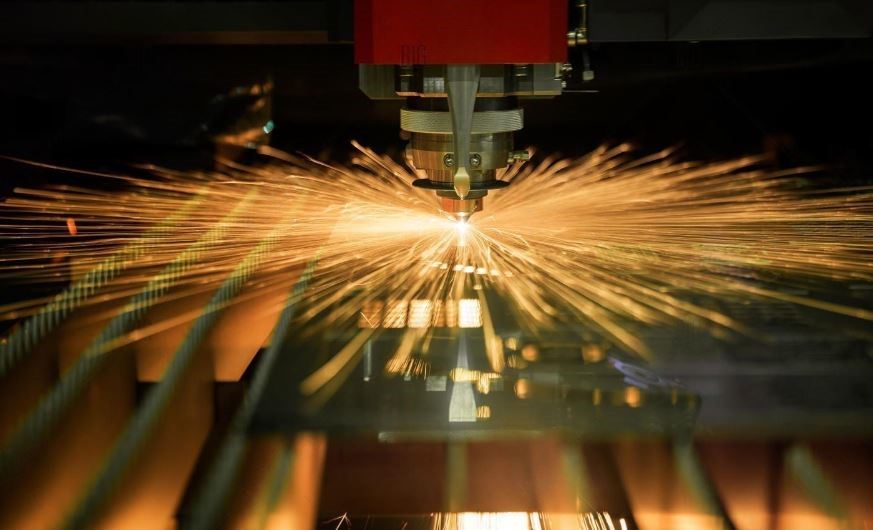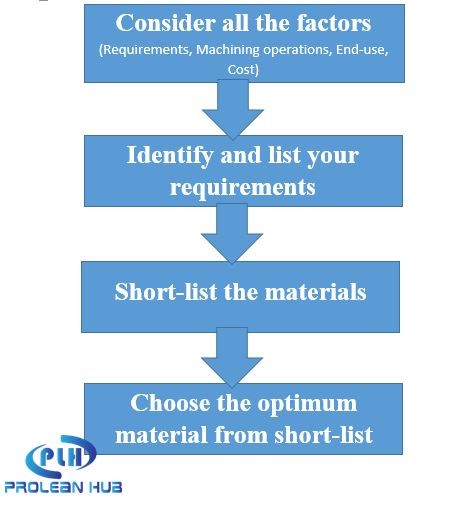Selection Of Best Sheet Metal For CNC Machining
There is no exact answer to the question of the best material for CNC machining. The best material is determined by the required machining process, end application, and part specification.
CNC machines can work with metal, plastic, wood, ceramics, composites, and fiber. However, Plastics and metals are the most used materials in CNC manufacturing. This article will discuss only sheet metal selection criteria, including all aspects of the selection approach, material optimization, and some best sheet metal alternatives.
Factors to consider
Several factors must be considered while deciding on the right material for your CNC machining project.
The factors can be divided into five categories.
- Parts specifications
- Required machining operations
- End-use applications
- Required properties
- Cost
1. Parts specifications
Sheet metal selection heavily depends on the required parts specification, which always holds certain specifications for their functionality. Some important specifications involve size, thickness, tolerance, and surface finish. While selecting the sheet metal options, these specification needs to be considered. Each type of sheet metal has different properties. These properties should be checked to determine whether they match the parts’ specifications.
If your parts are going to be used as-machined surface finish, then you might choose the sheet with an excellent surface finish. However, if surface finishing such as powder coating, Zinc plating, and painting will be applied, you might want to check which materials are feasible for the required surface finish. Similarly, you need to check the size, thickness, and tolerance are achievable or not with the type of metal sheet you are selecting for your project.
2. Required machining operations

CNC machining with sheet metal
According to the design of parts, Required CNC machining operations can be identified, such as milling, turning, drilling, and others. The metal sheet you select must be compatible with the required CNC machining operations. For example, if you select some particular metal incompatible with machining, your time and money will be wasted. For Example, Hardness is the key for your parts, and you select the hardened steel sheet, but later that cannot produce the required tolerance while machining.
So, you need to identify which machining operations are required and what type of sheet metal is compatible with those operations.
Metal characteristics influence the functionality, durability, and efficiency of parts. Regarding sheet metal options for CNC machining, end-use applications of parts are critical considerations. Before selecting the type of metal sheet, you should consider two crucial factors under end-use applications.
- Environment
You need to address the environmental conditions under which the parts will be employed in the end. Because the environment influences heat resistance, corrosion resistance, chemical resistance, and UV-ray exposure, the environmental element might not be that significant if your parts are used indoors. However, you must consider outdoor use temperature fluctuations, UV radiation, humidity, and chemical exposure.
As a result, sheet metal selection must be able to endure these working conditions. For example, if you need parts that will be used outdoors, you must ensure that the material you choose does not affect the tolerance by external conditions such as heat and moisture.
- Mechanical Strength
It is another consideration in end-use applications. The material must maintain the appropriate mechanical strength throughout the product’s life. Based on the use of the parts, you can figure out the required mechanical strength and the material that can provide that strength.
3. Required properties
Every part needs its own range of properties for functionality. Consequently, the desired properties of the part should match or fall within the range of Sheet metal properties (physical, mechanical, and chemical) while choosing the best CNC sheet metal.
The physical characteristics of sheet metal, such as tensile strength, strength-to-weight ratio, wear and tear resistance, and flexibility, will be determined by the application aspect of the parts. In general, heavier sheet metal has greater mechanical strength, but the parts’ weight limit must also be considered. Therefore, the recommended course of action is to compare mechanical strength and strength-to-weight ratio.
Let’s discuss some important properties to consider during the selection process.
- Weight
If the metal sheet fulfills the strength requirement for parts, then weight must be considered based on application. For example, the material must be extremely light if the parts are for aircraft.
- Machinability
The next characteristic is the machinability of the material. High machinability materials make CNC machining easier and help to maintain tight tolerances. So, the machinability of sheet metal also has a role in the selection process. Another thing that comes with machinability is compatibility with tools because If you consider the extremely tough material, that can destroy the machining tools.
- Thermal behavior
Examine materials’ thermal and electrical characteristics that fulfill operating conditions in final applications. Consider the electrical conductivity, melting point, and thermal expansion Coefficient. If you pick a material with a low melting point and your parts operate at high temperatures, that might lead to failure. At the same time, consider the electrical conductivity according to the desired application.
4. Cost
Cost is a key consideration when choosing the best sheet metal for CNC machining. Many materials are available in various pricing ranges that meet all the desired parts’ requirements. So, Cost must be considered along with the other factors. It is necessary to analyze the Cost of sheet metals based on their properties, such as machinability, strength, hardness, weight, and others.
For example, Aluminum is the best choice since it is less expensive than titanium, even though both materials meet the strength-to-weight requirements for choosing sheet metal for interior aircraft parts.
A three-step guide to selecting your best sheet metal

Above, we have discussed all the important factors influencing the sheet metal selection process and deciding which types of sheet metal would be ideal for any CNC machining project.
Based on the affecting factors, there are three crucial steps that you can follow to select the best sheet metal for your project.
Flow-chart for the selection process
Step 1: List your requirements.
We discussed that part requirement are key when choosing the best CNC material. It should be your top priority. So, list all the requirements such as Strength, Hardness, lightweight, elasticity, surface finish, and others.
Example:
|
Required properties |
Value/ Specification |
|
Tensile Strength |
Low (< 100 MPa), medium (< 500 MPa), or high (>500 MPa). You can fix the required tensile strength in a range ( i.e., X to Y MPa ) |
|
Compressive strength |
Choose from Low, medium, and high, or it also can be a specified range. |
|
Hardness |
Choose from Low, medium, and high, or it also can be a specified range( i.e., X to Y HRB ) |
|
Strength-to-weight ratio |
Low, medium, or high. It is better to specify a range for sensitive parts, such as parts for medical equipment. |
|
Surface finishing |
As machined, plating, painting, powder coating or any other types, for sensitive parts such as aircraft, It is better to specify a range of required roughness numbers (Ra). |
|
Machinability |
Specify Which type of machinability is needed on sheet metal ( High, medium, low) |
|
Tolerances |
± X to Y mm |
|
Elasticity |
High, medium, or low. |
Basically, List the requirements by specifying a range or category (Low, medium, and high). Another thing is that you can list any requirement, not limited to the example above.
Step 2: Short-list the materials
Let’s look at common types of sheet metal used in CNC machining. Now list the various metal types in line with the pre-listed specifications. The list of materials must be compatible with the requirements.
- Aluminum
Aluminum offers a high strength-to-weight ratio, machinability, ductility, thermal & electrical conductivity, corrosion resistance, and cost-effectiveness. It can be quickly machined and used in many industries, including automotive, aerospace, construction, home appliances, military, electrical, and electronics.
- Stainless steel
Stainless steel provides High mechanical strength, toughness, thermal resistance, wear and tear resistance, and sturdiness. Stainless steel has an attractive surface finish that is simple and has a bright silver tone. However, the type of alloy also affects the specific qualities. The three most popular alloys are 1215, 12L14, and 1018.
- Brass
Brass offers excellent machinability, high tensile strength, impact resistance, and shear resistance. It is very popular for low-friction manufacturing, aesthetic appeal, and strict tolerance production in Electrical, Electronics, Automotive, defense, aerospace, architecture, medical, Plumbing, and many more industries.
- Titanium
The main advantage of titanium is it can sustain extreme thermal, chemical, and moisture environments without changing its properties. It has high levels of biocompatibility, strength-to-weight ratio, and corrosion resistance, making it ideal for the automotive, aerospace, and medical industries.
- Copper
Although it is weak against substances like acids, halogen sulfides, and ammonia solutions, copper has great thermal and electrical qualities, high machinability, corrosion resistance, and a bright reddish brown appeal. It can be used for radiators, electrical valves, heating and cooling systems, and different electrical appliances.
- Others
Besides these, there are different metals with unique properties, such as Bronze, Zinc, and Magnesium.
Step 3: Select the best sheet metal from a short-list
Select the material that best satisfies all needs after narrowing down the choice of sheet metals made of various materials. When making a decision, take the price into account. If prices drop significantly, you may be able to compromise on some requirements without sacrificing functionality. However, if the parts are sensitive, you need to find the material which is highly compatible with the requirements.
Final thought
Selection of the best sheet metal for your CNC machining project is quite tricky. It includes considering different factors, but with Prolean, it is much simpler than you imagine, offering CNC machining services for over 50+ metals & alloys. We can machine the parts to your specifications with strict tolerances. Our experienced engineers will help you select the best materials within your budget and desired features.
FAQ’s
Which sheet metal would be the best for my CNC machining project?
There isn’t a single solution. The appropriate sheet metal for your CNC project will rely on several variables, including your needs and the characteristics of a particular type of sheet metal. For instance, Aluminum could be the best metal for interior aircraft parts, whereas steel sheet might be the best choice for structural components. Basically, it depends entirely on your needs.
What are the important factors to consider while selecting the best sheet metal for CNC machining?
There are different factors such as your requirements, end-use applications, the technical feasibility of manufacturing, Cost, and many more.
What are some common types of sheet metal used in CNC machining?
The most popular sheet metal materials used in CNC machining are steel, Aluminum, brass, titanium, copper, zinc, and bronze.
Article Source: https://www.proleanhub.com/news/select-the-best-sheet-metal-for-cnc-machining/
Media Contact
Company Name: Pro-Lean Technology Co., Ltd.
Email: Send Email
Country: China
Website: https://www.proleanhub.com/


